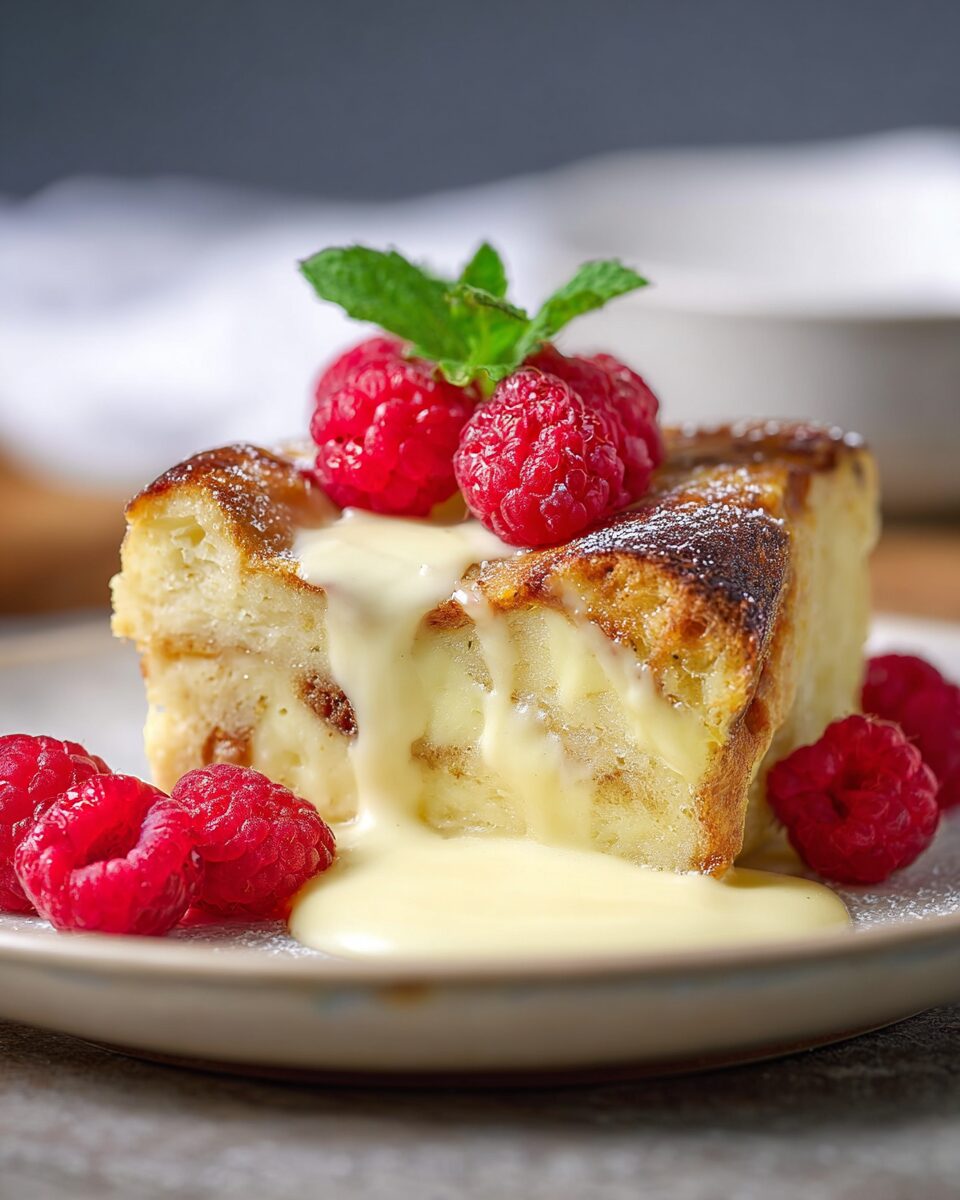This Custard Bread Pudding with Vanilla Sauce is the ultimate comfort food, with a rich, creamy texture that will melt in your mouth. The custard filling is perfectly sweetened, and the vanilla sauce adds a velvety finish to each bite.
It’s a dessert that’s perfect for a cozy family gathering or any occasion that calls for a warm, indulgent treat. The soft bread soaked in a sweet custard filling pairs wonderfully with the smooth, fragrant vanilla sauce. Whether enjoyed on its own or topped with a dollop of whipped cream, this bread pudding is sure to become a favorite.
Full Recipe:
-
8 slices of day-old bread, cubed
-
3 large eggs
-
2 cups whole milk
-
1/2 cup heavy cream
-
1/2 cup granulated sugar
-
1 teaspoon vanilla extract
-
1/4 teaspoon ground cinnamon
-
1/4 teaspoon salt
-
2 tablespoons unsalted butter, melted
Vanilla Sauce:
-
1/2 cup heavy cream
-
1/4 cup whole milk
-
1/4 cup granulated sugar
-
1 teaspoon vanilla extract
-
Pinch of salt
Directions:
-
Preheat your oven to 350°F (175°C). Grease a 9×9-inch baking dish with butter or cooking spray.
-
In a large mixing bowl, whisk together eggs, milk, heavy cream, sugar, vanilla extract, cinnamon, and salt until fully combined.
-
Add the cubed bread into the mixture and press down gently to make sure the bread soaks up the custard mixture.
-
Stir in the melted butter and let the bread mixture sit for 10-15 minutes to absorb the custard.
-
Pour the bread mixture into the prepared baking dish and bake for 35-40 minutes, or until the top is golden brown and the custard is set.
-
While the bread pudding is baking, prepare the vanilla sauce. In a small saucepan, combine the heavy cream, milk, sugar, vanilla extract, and salt over medium heat.
-
Stir constantly until the sauce is warmed and the sugar has dissolved. Remove from heat and set aside.
-
Once the bread pudding is done, allow it to cool slightly before serving. Drizzle the vanilla sauce over the top just before serving.
Prep Time: 15 minutes | Cooking Time: 40 minutes | Total Time: 55 minutes
Kcal: 350 kcal | Servings: 6 servings
History and Origin
Bread pudding is a classic dessert with roots that trace back to ancient times. While variations of bread pudding have appeared in many cultures throughout history, the dish’s origins are often attributed to Europe, specifically the United Kingdom. It was created as a way to use up stale or leftover bread, transforming it into a delicious and hearty treat that could feed a family. Known as a frugal yet flavorful dish, bread pudding was often made with the simplest ingredients: bread, milk, eggs, sugar, and spices.
The custard version of bread pudding—often seen in American and British recipes—began to appear in the 19th century, with an increase in the use of eggs and cream in the filling, giving it a richer and more luxurious texture. Vanilla, a beloved flavor worldwide, made its way into the recipe over time, becoming a popular addition to the sauce that tops the pudding. The vanilla sauce became a hallmark of this dessert, balancing the custard’s sweetness and adding a velvety finish.
Over the years, bread pudding has remained a household favorite in many cultures, evolving with regional preferences and available ingredients. From traditional British bread and butter pudding to American custard bread puddings, each version adds its own twist to this beloved dish.
Variations and Adaptations
Bread pudding has numerous variations across the globe, each region adapting it to its culinary traditions. In the UK, for example, bread and butter pudding is made by layering slices of buttered bread with dried fruits such as currants or sultanas, then pouring over a custard mixture before baking. This variation is less focused on a rich sauce and more on the custard-soaked bread.
In the United States, particularly in the South, bread pudding often takes a more decadent turn. Ingredients like pecans, bourbon, or even chocolate chips are added for extra flavor and texture. The dish is sometimes served with a drizzle of whiskey sauce or a dollop of whipped cream, further elevating its richness.
In some cultures, bread pudding is enhanced with tropical ingredients. For example, in the Caribbean, coconut milk and rum-soaked raisins may be used in place of traditional dairy products, offering a unique twist on the classic. In France, bread pudding might be found as part of the famous “pain perdu” (lost bread) tradition, which takes stale bread and turns it into a sweet, eggy dish similar to French toast, often served with fresh fruit and syrup.
This versatility makes bread pudding an easy recipe to adapt to different tastes. You can experiment with different types of bread—white, whole wheat, challah, or brioche—as well as varied toppings and mix-ins, like caramelized bananas, apple slices, or even a dash of cinnamon. The key is to balance the custard with the bread and add elements that suit your personal flavor profile.
Nutritional Information
Custard Bread Pudding with Vanilla Sauce, while undoubtedly indulgent, also has some nutritional value. Here’s a breakdown of its main components:
Calories: A typical serving of bread pudding (about one-sixth of the recipe) contains around 350–400 calories, depending on portion size and ingredients. This makes it a moderate dessert option, although it’s still on the richer side due to the milk, cream, and sugar.
Carbohydrates: The bread in this dessert provides a good amount of carbohydrates, which give you energy. One serving typically contains around 45-50 grams of carbs, depending on the bread used. If you use a whole-grain or higher-fiber bread, you can boost the fiber content.
Fats: The custard filling and vanilla sauce are made with heavy cream and butter, which contribute to the higher fat content. A typical serving can have anywhere from 15–20 grams of fat, most of which is saturated fat. While this isn’t the healthiest option, a small serving of this dessert won’t ruin a balanced diet when enjoyed occasionally.
Protein: The eggs and milk in the custard provide a moderate amount of protein, typically around 7-9 grams per serving. This helps balance the dish and offers some nutritional value beyond just sugar and fat.
Micronutrients: The eggs and milk also contribute essential vitamins and minerals like vitamin A, calcium, and iron. These nutrients are important for bone health, skin health, and overall well-being. However, for a more nutrient-dense variation, you could use alternatives like almond milk or fortified non-dairy creams.
Sugar: The sugar content of bread pudding is quite high, especially when paired with the vanilla sauce. A typical serving can have around 25–30 grams of sugar, which comes from both the custard mixture and the sauce. For those seeking a lower-sugar option, consider using natural sweeteners like honey, maple syrup, or stevia.
Serving Suggestions and Pairings
Custard Bread Pudding with Vanilla Sauce is a versatile dessert that can be paired with a variety of beverages and accompaniments. For a classic experience, serve it with a hot cup of coffee or a creamy cappuccino. The slight bitterness of coffee balances the sweetness of the dessert perfectly. For a richer pairing, a glass of dessert wine such as a sweet Riesling or a light Muscat complements the custard’s creamy texture and vanilla flavor.
If you want to add an extra layer of flavor, top your bread pudding with whipped cream, a dusting of powdered sugar, or even a scoop of vanilla ice cream. A drizzle of caramel or chocolate sauce could also add an indulgent touch. For a more refined experience, a sprinkle of toasted nuts like pecans or almonds provides a nice crunch that contrasts the smoothness of the pudding.
If you’re serving this dish as part of a larger meal, it pairs wonderfully with a light salad or fruit salad to balance out the richness. Fresh berries, such as raspberries or strawberries, are especially delightful alongside the creamy custard. You could also serve it after a savory meal like roasted chicken or a comforting bowl of soup, making it a perfect way to round off a cozy dinner.
Tips and Tricks for Success
To ensure your Custard Bread Pudding with Vanilla Sauce turns out perfectly, follow these tips:
-
Use Stale Bread: For the best texture, use day-old or slightly stale bread. Fresh bread can become too soggy when soaked in the custard mixture, while stale bread absorbs the liquid evenly and becomes soft but not mushy.
-
Don’t Overmix the Custard: When whisking together the eggs, milk, and sugar, be careful not to overbeat. Overmixing can create bubbles or cause the custard to become too airy. Just whisk until everything is fully combined.
-
Let it Soak: Allow the bread mixture to soak for at least 10–15 minutes before baking. This ensures that the bread absorbs the custard mixture and the pudding becomes rich and smooth.
-
Test for Doneness: The bread pudding is done when the top is golden brown and the center is firm but slightly wobbly. You can insert a knife into the center to check for doneness; it should come out clean, not runny.
-
Customize with Flavors: Don’t be afraid to add spices or other flavorings like nutmeg, cloves, or orange zest. These subtle additions can enhance the overall flavor of the dish.
Potential Health Benefits
While Custard Bread Pudding with Vanilla Sauce is not the healthiest dessert option, it does provide some benefits due to its ingredients. The eggs offer a good source of protein, while the milk and cream provide calcium, which is essential for strong bones. Cinnamon, often added to the custard mixture, has anti-inflammatory properties and may help regulate blood sugar levels. Additionally, using whole-grain bread instead of white bread can add fiber, which is beneficial for digestive health.
Conclusion
Custard Bread Pudding with Vanilla Sauce is more than just a dessert; it’s a comforting, nostalgic treat that brings warmth and joy to any meal. With its creamy custard base, soft bread, and velvety vanilla sauce, this dessert is the perfect way to end a hearty dinner or impress guests at a special occasion. Easy to customize with different flavorings or toppings, it’s a dessert that can fit any occasion. Whether you’re a seasoned baker or a beginner, this dish is sure to be a crowd-pleaser. So why not give it a try and enjoy a serving of comfort in every bite?





